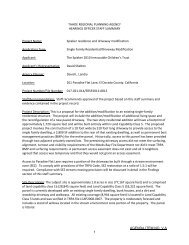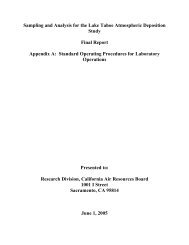FEIS - Tahoe Regional Planning Agency
FEIS - Tahoe Regional Planning Agency
FEIS - Tahoe Regional Planning Agency
Create successful ePaper yourself
Turn your PDF publications into a flip-book with our unique Google optimized e-Paper software.
RESPONSE TO COMMENTS ON THE DEIS<br />
B o u l d e r B a y C o m m u n i t y E n h a n c e m e n t P r o g r a m P r o j e c t E I S<br />
The DEIS traffic study determined baseline traffic volumes by applying trip generation assumptions used<br />
for determining the impacts of the Project and Alternatives to the existing land uses that operate within<br />
the project area. TRPA has confirmed that for purposes of determining the level of environmental impact<br />
in the DEIS and <strong>FEIS</strong>, the methods used in the original study contained in the DEIS is consistent with and<br />
in compliance, procedurally and substantively with the TRPA Code of Ordinances as well as other traffic<br />
studies conducted by TRPA for recent Environmental Impact Studies. The DEIS traffic study is also<br />
consistent with the guidelines for completion of traffic impact studies to determine level of impact<br />
published by the Community Development Departments for Washoe County, Placer County, Carson<br />
City/County, Douglas County and El Dorado County.<br />
In order to respond to comments regarding the adequacy of the DEIS traffic study, TRPA asked for the<br />
preparation of an alternative baseline conditions study. The Boulder Bay Alternative Baseline Existing<br />
Conditions Traffic Volumes Technical Memorandum (Fehr & Peers, 2010) addresses concerns raised<br />
during circulation of the DEIS about the existing and baseline existing trip generation of the <strong>Tahoe</strong><br />
Biltmore. The memo is added as Appendix AA of the <strong>FEIS</strong> and presents an alternative traffic analysis<br />
using the actual 2008 traffic counts adjusted to the year 2006 to account for economic conditions that<br />
existed in 2008. The technical memorandum includes:<br />
• A detailed explanation of the traffic data collection process.<br />
• The methodology for determining PM and daily trip generation of the <strong>Tahoe</strong> Biltmore based<br />
on the collected traffic volumes, rather than the ITE and TRPA trip generation rates.<br />
• The methodology for correcting the baseline existing conditions based on operating<br />
conditions and economic fluctuations.<br />
• A comparison of each Alternative’s modeled trip generation to the existing and baseline<br />
existing trip generation of the <strong>Tahoe</strong> Biltmore and other land uses included in the project<br />
area.<br />
The overall existing trip generation of the <strong>Tahoe</strong> Biltmore project area was calculated based on the<br />
intersection traffic volumes collected in 2008, plus trip generation estimates from the Nugget Casino<br />
overflow parking lot, the Crystal Bay Motel, and the Crystal Bay office space, which were not included in<br />
the 2008 traffic counts, but are now included as part of the Boulder Bay project area.<br />
The trip generation estimates for Alternatives B, C, D and E are based upon Institute of Transportation<br />
Engineers (ITE) trip generation rates. These trip generation rates assume optimal operating conditions<br />
during the peak time of the year during a normal economic year. During the summer of 2008, Lake <strong>Tahoe</strong><br />
and the broader US economy were in the midst of the worst economic downturn since the 1930’s. At the<br />
same time, gas prices were over $4.00/gallon. Both situations led to dramatic temporary declines in<br />
visitation to Lake <strong>Tahoe</strong>. Based on an analysis of Nevada Gaming numbers for North Lake <strong>Tahoe</strong> and<br />
Biltmore audited financials, it was estimated that visitation was off by 28% in 2008 vs. normal economic<br />
conditions in 2006. (It is important to note that this does not include the decline due to the growth of<br />
tribal gaming in California. This decline, estimated at 32%, was viewed as a permanent decline and was<br />
not adjusted for in the calculation. Estimated Average Peak Daily Trips would be 5,853 if a recovery in<br />
gaming was included.) Due to the unique conditions of 2008, the baseline existing conditions analysis<br />
looks back two years previous to when the traffic counts were collected, consistent with the two-year<br />
window that TRPA considers for an “existing” use. This two-year look back provides a more consistent<br />
comparison between the existing conditions and ITE trip generation estimates for Alternatives B, C, D,<br />
and E.<br />
Table 8.5-2 shows the daily and PM peak hour trip generation of the existing <strong>Tahoe</strong> Biltmore (based on<br />
the traffic volumes collected in 2008, plus trip generation estimates from the Nugget Casino overflow<br />
parking lot, the Crystal Bay Motel, and the Crystal Bay office space), the baseline existing conditions<br />
SEPTEMBER 8 , 2010 HAUGE BRUECK ASSOCIATES PAGE 8- 17






